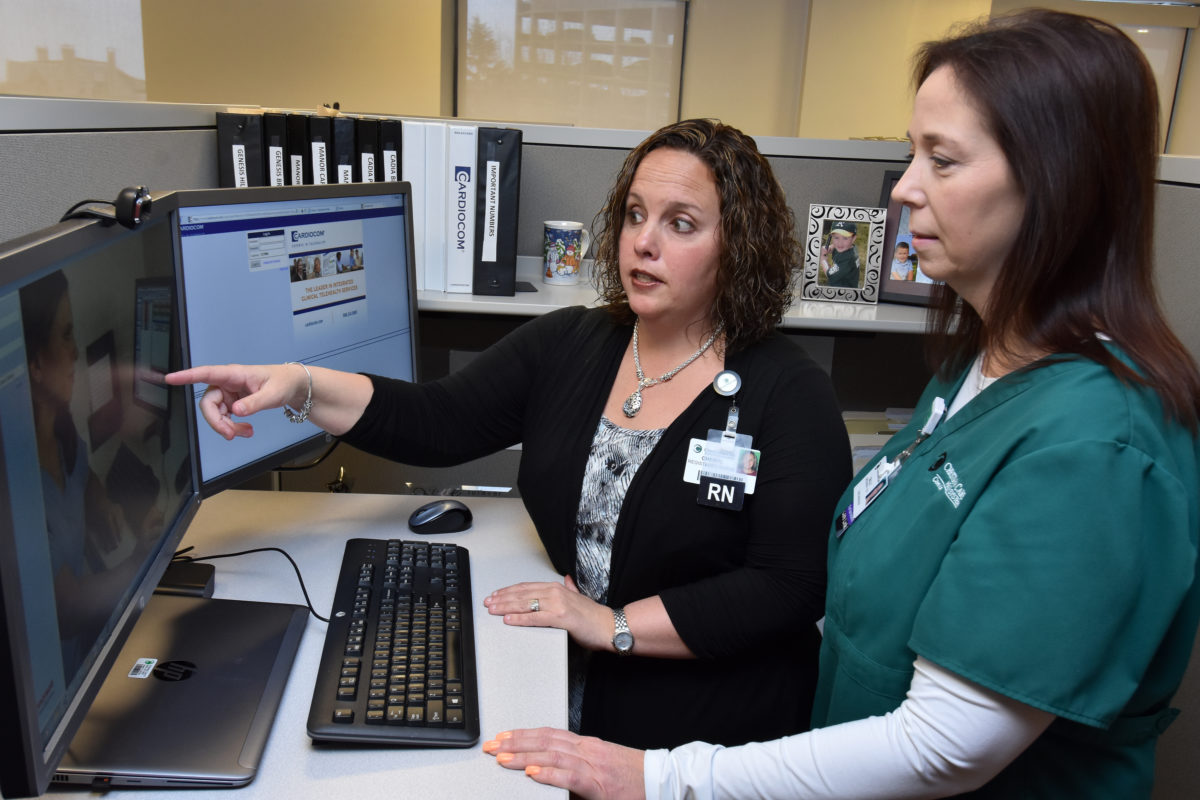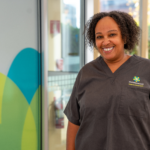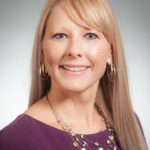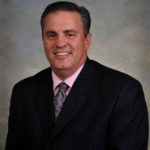Cheryl Alexander, MSN, RN, sits before a computer screen, monitoring the vital signs of about 60 homebound patients. They are among the thousands who are being tracked by Christiana Care’s Care Link staff, whose cubicles surround her.
Alexander is the lead cardiac clinician for Christiana Care Health System’s Visiting Nurse Association, and it’s her job to spot trouble.
In the Camden office, Monica Matthews, RN, works with the Care Link teams to improve telehealth-related outcomes, said Lori Davis-Palmer, RN, clinical director for the VNA.
These patients, who receive in-home care, have been equipped with a scale, a blood pressure cuff and a pulse oximeter that measures the level of oxygen in their blood. Each morning at a set time, they use this equipment to register their data, which shows up on Alexander’s monitor.
The system ranks warning signs, like overnight weight gain of more than 3 pounds, which can mean that a patient is retaining a dangerous amount of fluid. That’s when Alexander makes her calls.
“Sometimes I’ll call and the person will laugh and say, ‘Cheryl, I knew you were going to call! I had Chinese food last night,’” she said, explaining that the salt leads to water retention. “My job is to teach them what these numbers mean, why they’re important and how to manage them. The more we can keep them home and out of the hospital, the better chance they have at optimal health.”
Andrea Huertas, MBA, BSN, clinical director for the VNA, said that from February 2015 to February 2016, 16.48 percent of all patients in the visiting nurse program were admitted to the hospital, but only 10.75 percent of those being telemonitored by Alexander and her downstate counterpart were hospitalized.
“Monica regularly participates in weekly, multidisciplinary case conferences and physician-based case conferences, where she collaborates with the team to report trends and concerns regarding patient conditions and offers suggestions for care improvements and referrals,” Davis-Palmer said. “She has been instrumental in working with our clinical coordinator to identify cases early-on for telemonitoring opportunities, which is the most effective time to have monitoring to prevent rehospitalization.”
According to Huertas, telemonitoring helps the team to stay one step ahead of potential crises. “With the immediacy of the technology, we can get real-time data over to the primary care physician or cardiologist,” she said.
Sometimes it helps just having someone to talk to, Alexander said, recounting how on a recent morning she called a 91-year-old patient whose vital signs looked weak. She spoke with his wife and learned that he hadn’t yet taken his medication, and once he did, everything returned to normal.
“She got a little teary, and said, ‘Cheryl, if you weren’t on the other line, I wouldn’t know what to do,’” Alexander said.
The VNA began telemonitoring patients about 10 years ago, starting in rural areas in lower Delaware where it was tougher to get to a hospital, said Andrea Dickerson, BSN, RN, nurse manager for the VNA cardiac team.
With the expansion of the Care Link program, she said, it made sense to embed Alexander in their new headquarters last fall to take advantage of the programs’ synergies. Once a patient is ambulatory again, he or she will remain in the Care Link system.
An important aspect of the telemonitoring process is teaching people how they can take control of their health, Dickerson said.
The program recently switched over to new software that includes an educational component. After a patient records his weight, blood pressure and oxygen reading, the monitor will ask three questions related to the patient’s disease — are their feet swollen, for example, or are they short of breath? Using branch logic, the system will call out troubling results.
“It helps people understand what’s going on with their bodies,” Dickerson said. “I could sit there all day and say, ‘You need to do this or that.’ But they see what happened — yesterday you didn’t take your water pill, and now you’ve gained 4 pounds and are feeling uncomfortable.”
Regardless of a patient’s answers, the system can pick up on subtle trends.
“They may be answering no to all of the questions, but we see their blood pressure is going down,” Dickerson said. “Research has shown that there will be slight differences that can be picked up 18 days before a full-blown cardiac event.”
It also provides daily snippets of health education for the patient. Anthony Tramonte, 73, took advantage of the telemonitoring program after being treated for congestive heart failure. Learning more about his condition has led him to shed 40 pounds and become more aware of what his body is telling him so that he doesn’t wind up back in the hospital.
“You learn a lot about yourself, how to work with the nurses, how to help them help you,” he said. “It makes you feel like somebody cares about you. That and your home environment are very important for your healing.”



